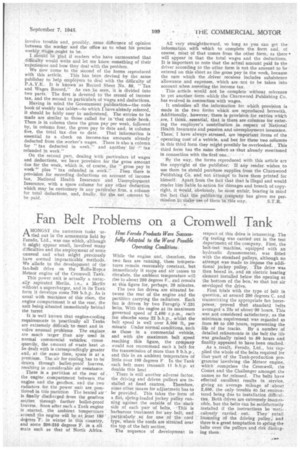Fan Belt Problems on a Cromwell Tank • How Feroclo Products
Page 35

If you've noticed an error in this article please click here to report it so we can fix it.
Were Surre9cfully Adapted to. the Worst Possible Operating Conditions. A MONGST the numerous tasks arried out in the armaments field by Ferodo, 'Ltd., was one which, although it might appear small, involved many difficulties and the employment of some unusual and what might previously have seemed impracticable methods. We allude to the development of ehe fan-belt drive on the Rolls-Royce Meteor engine of the Cromwell Tank. This power. unit is actually a natty,. ally aspirated Merlin, he„ a Merlin without a supercharger, and in its Tank form it develops some 700 b.h.p. As is usual with machines of this class, the engine compartment is at the rear, the unit being situated immediately behind the turret It is well known that engine-cooling requirements in 'practically all Tanks are extremely difficult to meet and in volve unusual problems The engines are much targetthan any used in normal commercial vehicles; -conse quently, the amount of waste heat oe be dealt with is correspondingly greater and, at the same time, space is at a.. premium. Me air for cooling has to he drawn through bullet-proof louvres, resulting in considerable air resistance
There is a partition at the rear of the engine compartment between the engine and the gearbox, and the two radiators for the power unit are
tinned in in this partition The heated air is festally dischargedfrom the gearbox section through further bullet-proof louvres. Soon after such a Tank engine is started, the ambient temperature around the engine will be at ,least 180 degrees 'F. in winter in this country, and some 200-210 degrees F. in a cli mate such as that of North Africa.
While the engine and, therefore, the two fans are running, these temperatures remain reasonably constant, but immediately it stops and air ceases to circulate, the ambient temperature will rise to about 250 degrees F., and remain at thie figure for, perhaps, 20 minutes.
The two fan drives are situated between the rear of the engine and the partition carrying the radiators. Each fan is driven by two Ferogrip V.281 belts. With the engine at its maximum governed speed of 2,400 r.p.m., each Ian absorbs some 22 b.h.p„ whilst the belt speed is well over 5,000 ft,, per minute Under normal conditions, such as those in a commercial vehicle, and with the maximum belt speed reaching this figure, the company would not recommend such a belt lot the transmission of more than 9 b.h.p , and this in an ambient temperature of little over 100 degrees F In the Tank each belt must transmit 11 b.h.p. at double this heat
There is still another adverse factor, the driving and driven pulleys are in
stalled at fixed centres. Therefore, some other means for adjustment has to be provided. This takes the. form of a flat, spring-loaded jockey pulley running against the outside of the slack side of each pair of belts. This is barbarous treatment for any belt, and particularly so for one of the cord type, where the cords are situated near the top of the belt section.,
The sequence of development in
respect of this drive is interesting. The rig testing was carried out in the test department of the company. First, the belt-test 'machine, equipped with an hydraulic dynamometer, was fitted with the standard pulleys, although no attempt was made to impose the additional jockey pulley. The drive was then boxed in, and an electric heating element installed below the opening at the bottom of the box,' so that hot air enveloped the drive.
First trials with the type of belt in question, at around 200 degrees C. and transmitting the appropriate fan horsepower, proved that standard belts averaged a life of about-80 hours. This was pot considered satisfactory; as the minimum requirement was regarded as from 80 to 190 hours, representing the life of the tracks. By a number of detailed refinements in the belt the life was gradually raised to e0 hours and finality appeared to have been reached.
As a result, Ferodo, Ltd., has supplied the whole of the belts required for that partof the Tank-production pro'grammeinvolving the Meteor engine. which comprises the Cromwell, the Chniet and the Challenger amongst the names so far, released. The belts have effected excellent results in service, giving an average mileage of about 2.500, the only trouble so far encountered being due to installation difficulties. Both drives are extremely 'fleeces. sible, but the belts Can be satisfactorily installed if the instructions be 'meticulously carried out. They enta.il loosening of the driving pulley„ and there is a great temptation to spring the belts over the pulleys and risk daniagtag them.




















































